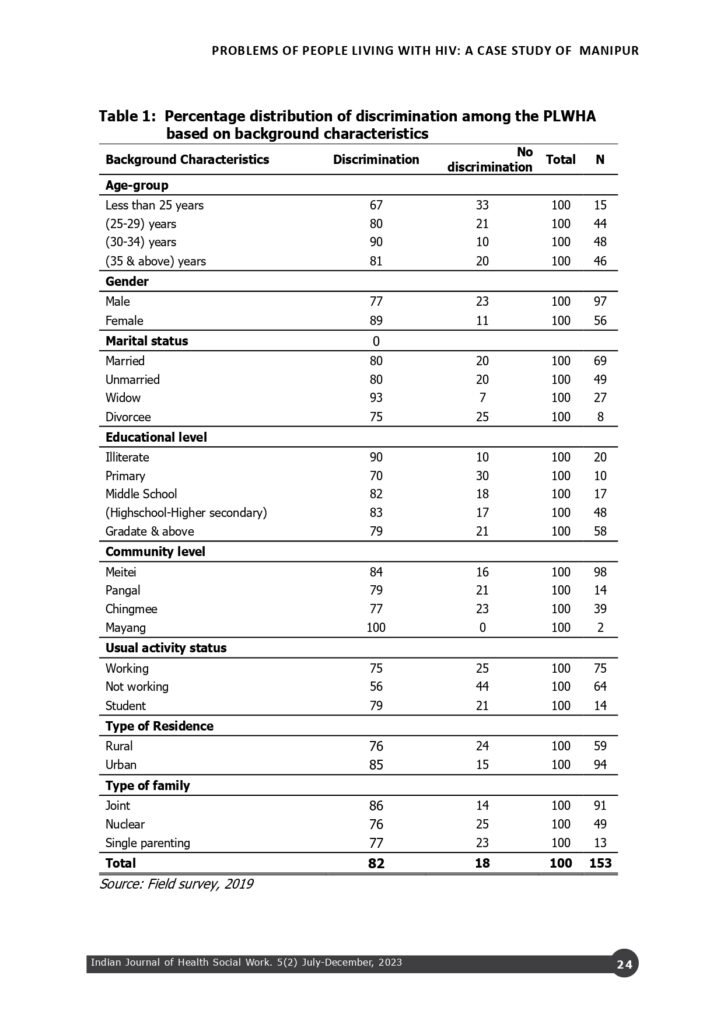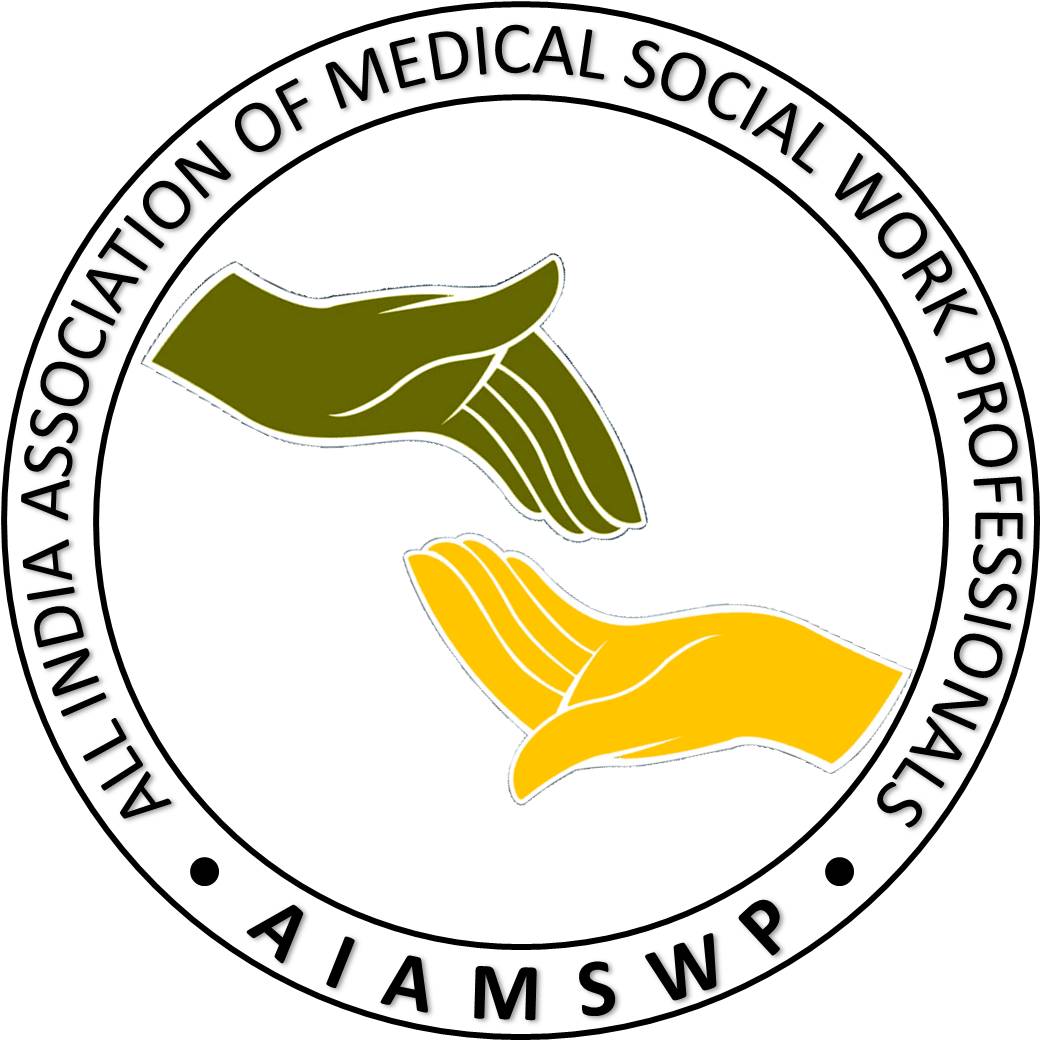Indian Journal of Health Social Work
(UGC Care List Journal)



REFERENCES
Brown, L.; Macintyre, K.; Trujillo, L (2003).
Interventions to reduce HIV/AIDS
stigma: What have we learned? AIDS
Educ. Prev. 15, 49–69.
Greenwood, G.L.; Wilson, A.; Bansal, G.P.;
Barnhart, C.; Barr, E.; Berzon, R.;
Boyce, C.A.; Elwood, W.; Gamble
George, J.; Glenshaw, M.; et al.,
(2021). HIV-Related Stigma Research
as a Priority at the National Institutes
of Health. AIDS Behav. 1–22.
Janahi ,E.M.; Mustafa, S.; Alsari S.; Al
Mannai, M.; Farhat, G.N. (2016).
Public knowledge, perceptions, and
attitudes towards HIV/ AIDS in
Bahrain: a cross-sectional study. The
Journal of Infection in Developing
Countries. 10(09):1003-1011.
doi:10.3855/jidc.7665.
Joint United Nations Programme on HIV/AIDS
((2023). Global HIV & AIDS statistics- fact sheet. UNAIDS. https://
www.unaids.org/en/resources/fact
sheet
.
Joint United Nations Programme on HIV/AIDS.
India. UNAIDS (2022). https://
www.unaids.org/en/regionscountries/
countries/india
.
Katz, I.T.; Ryu, A.E.; Onuegbu, A.G.; Psaros,
C.; Weiser, S.D.; Bangsberg, D.R.;
Tsai, A.C. (2013). Impact of HIV
related stigma on treatment
adherence: Systematic review and
meta-synthesis. Journal of the
International AIDS Society. 16 (Suppl.
2), 18640.
Kefale B, Damtie Y, Yalew M, Adane B,
Arefaynie M. (2020). Predictors of
comprehensive knowledge of HIV/AIDS
among people aged 15–49 years in
Ethiopia: a multilevel analysis. HIV
AIDS (Auckl). 12:449-456.
Narain, J.P. (1994). Risk factors for HIV
transmission in India. AIDS (London,
England) 8, S77–S82.
National AIDS Control Organisation (2015).
Part-B National AIDS Control
Organisation. NACO. https://
naco.gov.in/sites/default/files/
annual_report%20_NACO_2014
15_0.pdf.
National AIDS Control Organisation (2020). Sankalak: Status of National AIDS
Response. NACO.
National AIDS Control Organisation (2022).
Part-B National AIDS Control
Organisation.NACO.https://
naco.gov.in/sites/default/files.
Nubed. C.K & Akoachere, J.T.K. (2016).
Knowledge, attitudes and practices
regarding HIV/AIDS among senior
secondary school students in Fako
Division, South West Region,
Cameroon. BMC Public Health. 16(1).
Rintamaki, L.; Kosenko, K.; Hogan, T.; Scott,
A.M.; Dobmeier, C.; Tingue, E.; Peek,
D. (2019). The Role of Stigma
Management in HIV Treatment
Adherence. International Journal of
Environmental Research and Public
Health, 16, 5003.
Saha, M.K.(2000). Prevalence of HCV & HBV
infection amongst HIV seropositive
intravenous drug users & their non
injecting wives in Manipur, India.
Indian Journal of Medical Research.
111, 37–39.
Shrivastava, S.; Shrivastava, P.; Ramasamy,
J. (2019). Challenges in HIV care:
Accelerating the pace of HIV-related
services to accomplish the set global
targets. Annals of Tropical Medicine
and Public Health. 10(3).
Stangl, A.L.; Lloyd, J.K.; Brady, L.M.; Holland,
C.E.; Baral, S. (2013). A systematic
review of interventions to reduce HIV
related stigma and discrimination from
2002 to 2013: How far have we come?
International Journal of Environmental
Research and Public Health, 16, 2;
18734.
Teshome, R.; Youjie ,W.; Siraj, N. (2016).
Comparison and association of
comprehensive HIV/AIDS knowledge
and attitude towards people living
with HIV/AIDS among women aged 15
49 in three East African Countries:
Burundi, Ethiopia and Kenya. Journal
of AIDS & Clinical Research. 7(4).
doi:10.4172/2155-6113.1000559
Tran, B.X.; Phan, H.T.; Latkin, C.A.; Nguyen,
H.L.T.; Hoang, C.L.; Ho, C.S.H.; Ho,
R.C.M. (2019). Understanding Global
HIV Stigma and Discrimination: Are
Contextual Factors Sufficiently
Studied? (GAP(RESEARCH)). Int. J.
Environ. Res. Public Health. 16, 1899.
UNAIDS (2020). Joint United Nations
Programme on HIV/AIDS. 90–90–90:
good progress, but the world is off
track for hitting the 2020 targets.
https://www.
unaids.org/en/
resources/presscentre/featurestories/
2020/september/20200921_90-90-90.
United Nations (2015). Transforming our
world: The 2030 agenda for
sustainable development. UN. https:/
/sdgs.un.org/2030agenda
.
Vanable, P.A.; Carey, M.P.; Blair, D.C.;
Littlewood, R.A (2006). Impact of HIV
related stigma on health behaviors
and psychological adjustment among
HIV-positive men and women. AIDS
Behavioral. 10, 473–482.
Vorasane, S.; Jimba, M.; Kikuchi, K.; Yasuoka,
J.; Nanishi, K.; Durham, J.; Sychareun,
V. (2017). An investigation of
stigmatizing attitudes towards people
living with HIV/AIDS by doctors and
nurses in Vientiane, Lao PDR. BMC
Health Service Research, 17, 125.
Warren, C.E.;Hopkins, J; Narasimhan, M.
Collins, L.; Askew, I.; Mayhew, S.H.
(2017). Health systems and the SDGs:
lessons from a joint HIV and sexual
and reproductive health and rights
response. Health Policy Plan. 33,
4;102- 107.
World Health Organization. HIV. WHO; (2022).
https://www.who.int/news-room/
fact-sheets/detail/hiv-aids
.
Yadav, J., Gautam, S., Singh, K. (2016). Differential in awareness and
comprehensive knowledge of HIV/AIDS
and its determinants among youth in
India: a population based cross
sectional
study.
American
International Journal of Research in
Humanities, Arts and Social Sciences.
222-230.
Zeng, W.; Shepard, D.S.; Avila-Figueroa, C.;
Ahn, H. (2016). Resource needs and
gap analysis in achieving universal
access to HIV/AIDS services: a data
envelopment analysis of 45 countries.
Health Policy and Planning, 31(5):624
633.
Conflict of interest: None
Role of funding source: None


